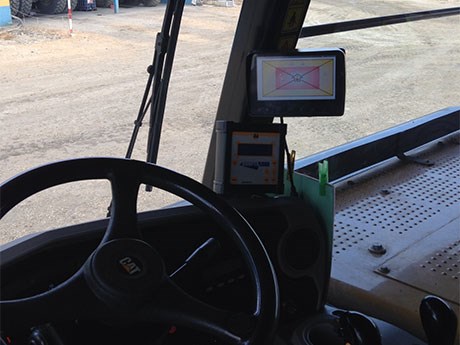System provides equipment operators with visual and audible alerts when they are in proximity to workers or other vehicles equipped with RFID tags
A Timmins-area mine has equipped its surface fleet with the Total Detector collision avoidance system developed by Torsa, a company based in Malaga, Spain.
Supplied by Provix Inc. of Alliston, Ontario, the Total Detector system provides equipment operators with visual and audible alerts when they are in proximity to workers or other vehicles equipped with RFID tags. Each haul truck, shovel and dozer is equipped with four antennae – one on each corner of the vehicle – and a seven-inch LCD monitor in the cab. When the system detects a signal, the monitor shows the operator if the person or vehicle is in front, behind or on one side or the other of the equipment.
“The difference between the Total Detector system and other collision avoidance systems is our four antennae,” said Provix technical sales consultant Karly Winfield. “The other systems have one antenna, so they will detect something is there, but they won’t tell you where.”
Knowing the precise location of a potential hazard is critical for an operator of a big haul truck because of the size of the vehicle and the operator’s obstructed view of his surroundings, said Winfield.
The fleet was already equipped with camera systems and monitors, so Provix integrated the two systems with a single monitor that’s able to show the camera views or the RFID alerts.
Each antenna is independently configurable.
“For example, if I want to detect someone in front of me sooner than I want to detect someone beside me, I can do that,” said Winfield. “I can also configure personnel and vehicles differently, so I’m alerted to a person within a range of 10 metres and a piece of equipment within a range of 20 metres.”
Fixed assets such as fuel tanks, compressors, generators or berms can also be equipped with RFID tags to keep equipment operators from running into them.
The RFID tags can be used to track personnel and regulate airflow as part of a ventilation on demand system in an underground mine. However, the ability to integrate the Total Detector system with RFID tags a mine has already deployed for other applications depends on the chirp rate of the tags.
A tag that emits a signal every five seconds as opposed to every fifth of a second wouldn’t be appropriate for a collision avoidance system because during that time lag something or someone could come in range of a piece of equipment, said Winfield.
The Total Detector system has received Industry Canada approval, certifying that the frequency it operates on doesn’t interfere with other signals.
Provix serves the mining industry across North America, and specializes in camera systems. Established in 1987, the company has a relationship with Laurentian University’s Centre for Research in Occupational Health and Safety (CROSH), which conducts line-of-sight research on mining equipment.
“CROSH has line-of-sight studies for the Kiruna electric truck, the CAT45D haul truck, and other pieces of equipment that tell us what the operator can see and where we have to install cameras to increase situational awareness,” said Winfield.
Provix also specializes in customized video solutions.
At Vale’s Creighton Mine, for example, Provix supplied a portable, tripod-mounted camera system that allows miners using a 15-inch LCD monitor to remotely operate an ITH (in-the-hole) drill from 250 feet away.
Another customer, the Diavik Diamond Mine in the Northwest Territories, acquired camera systems to enable remote
bolting.
Miners comfortably seated in a Sea-Can 150 feet away from the bolter view video from pan-tilt-zoom cameras to position the screen and install the bolts. Using the camera’s zoom capability, they can see more clearly than if they were in the bolter, said Winfield.
Provix also supplies camera systems for loading chutes, allowing a driver to see when he has a full load full without having to exit his truck.
The mining industry accounts for a significant percentage of Provix’s business, but the company also supplies camera systems to municipalities and utilities for snowplows, street sweepers and bucket trucks.
In the U.S. market, Provix does business with Hecla Mining and Kinross’ Fort Knox open pit in Alaska and Barrick’s Turquoise Ridge Mine and Kinross’ Round Mountain operation in Nevada.



